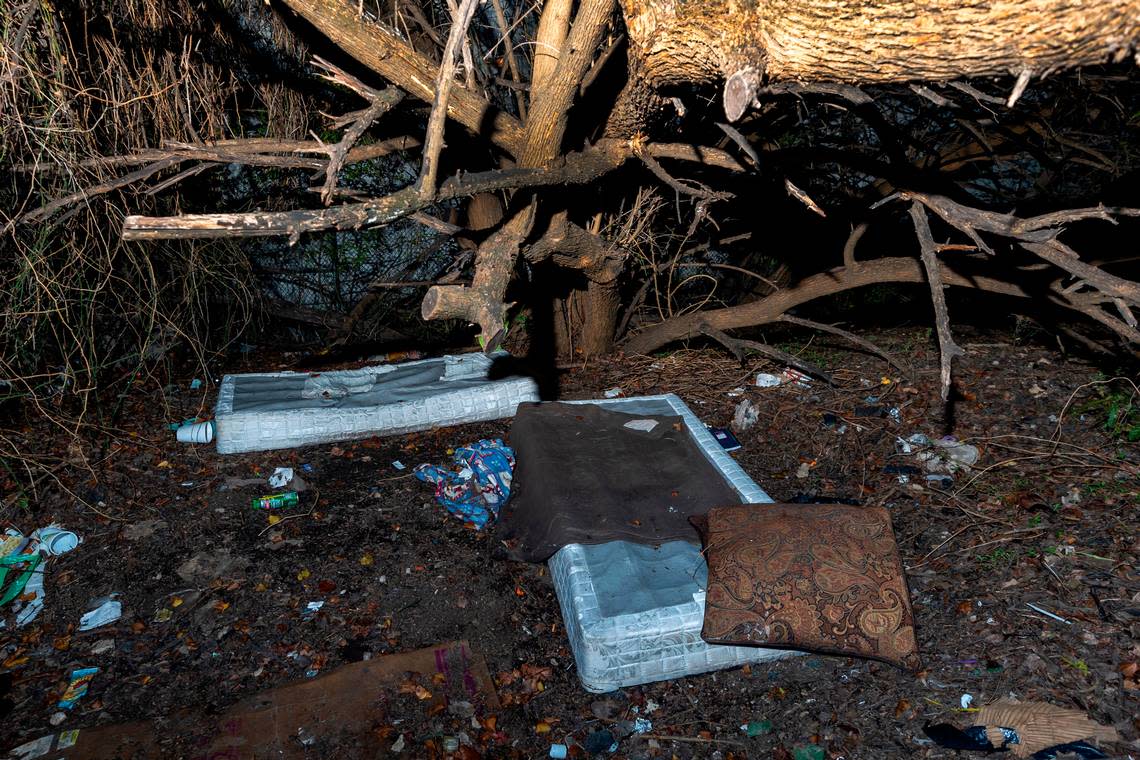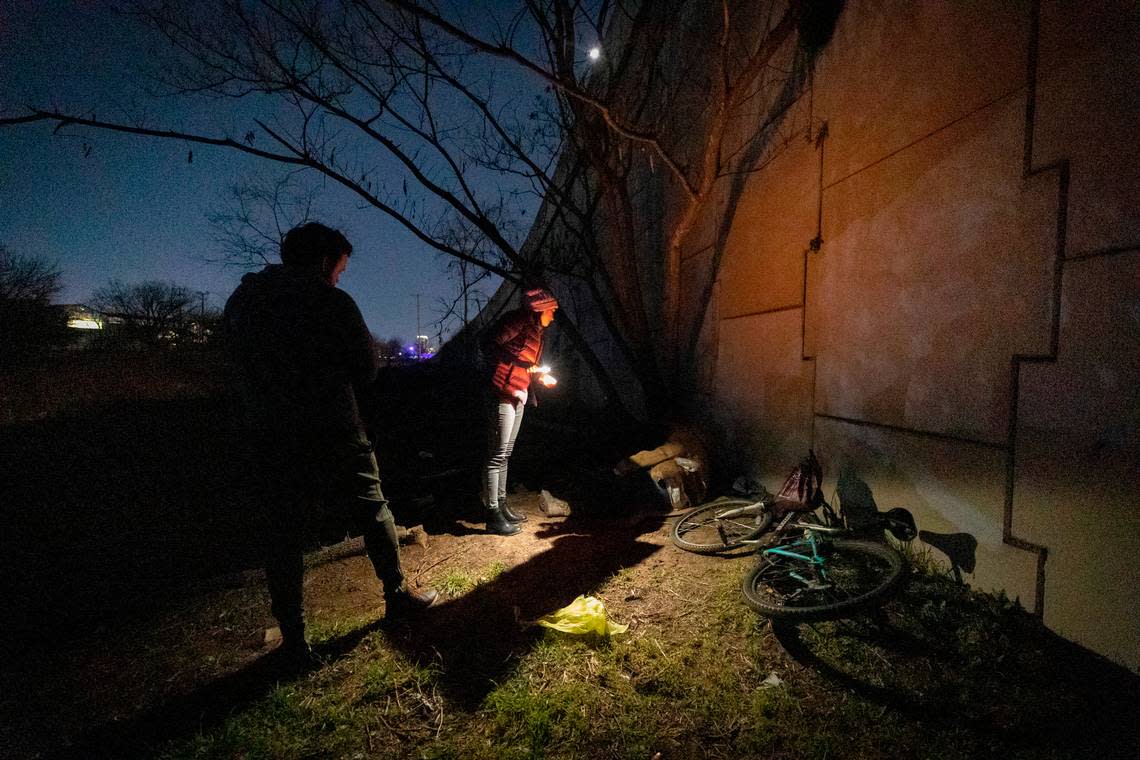Why did homelessness skyrocket in 2022? And why were so many Black people affected?
As rent relief came to an end and costs for housing increased, Tarrant County saw homeless numbers surge in 2022, and Black residents were disproportionately affected.
More than 5,000 households experienced homelessness throughout 2022 in Tarrant County, according to the Tarrant County Homeless Coalition. Comparatively, around 3,300 households experienced homelessness in 2021. The county hasn’t seen these kinds of numbers since before 2019.
At the end of December, there were around 2,000 households experiencing homelessness.
About 43% of the homeless population in the last quarter of 2022 was Black, though Black residents only account for 19% of the county’s residents.
The Tarrant County Homeless Coalition breaks down the homeless population into three categories: veterans, individuals and families, with families defined as at least one adult and one child. Black residents represented 70% of homeless families.
Experts say rising housing costs and the end of pandemic-era assistance programs fueled last year’s homelessness surge. And as economic inequality increases in DFW, racial disparities in systems such as public education, job accessibility and criminal justice have led to Black residents being over-represented in the homeless population, experts say.
Hannah Lebovits, public affairs and planning professor at the University of Texas at Arlington, said economic inequality is growing in major metro regions, including Fort Worth and Tarrant County.
Across the country, cities have rates of poverty above the national average while also having high median incomes. As high earners move back into cities, new housing developments prioritize them and inflame housing in-affordability, she said.
As of 2021, Fort Worth’s poverty rate (14.4%) was higher than the national average (12.8%) and slightly higher than the state average (14.2%). Fort Worth’s poverty levels were also higher than Dallas (14.3%) and Arlington (11.9%).
Meanwhile, the city’s median income has increased over the past five years, excluding a minor dip in 2020.
Lebovits said development is happening at a fast rate in Dallas-Fort Worth, with new units replacing older, less expensive buildings. That has resulted in more people moving in with family members and more people experiencing homelessness, she said.
She said there is a limitation to what poverty rates say about a city, as some people who are displaced move elsewhere and are no longer represented in the poverty rate of the city they left.
Lebovits said the Metroplex isn’t different from other metro regions in regard to inequality, poverty and gentrification. But there is a difference in perception, she said.
“This is a region that thinks it doesn’t have a poverty problem,” she said.
Lauren King, executive director of the Tarrant County Homeless Coalition, said disparities within other systems such as education and criminal justice can disproportionately fail Black residents and result in homelessness. The homeless support system becomes the last safety net to catch someone when every other system has failed them, she said.
“It’s a reflection of some overall systemic issues that exist and don’t work necessarily for people of color,” she said.
She said while it’s difficult for her organization to try to fix those larger issues of inequity, it can try to make sure the available homeless resources are equitable.
Recent increase in family homelessness
In October, King met with Fort Worth city leaders as family homelessness surged and emergency shelters were at capacity and had to turn away families. During the meeting, Fort Worth Mayor Mattie Parker said there were 340 children in Fort Worth shelters in August.

King recently told the Star-Telegram that her organization saw a plateau of homeless families in November and a small decrease in December, but she attributes that to the holidays and people with homes being more willing to take people in.
She said the number of homeless families returned to high levels in January, with places like the Salvation Army operating an overflow shelter.
King said the increase is a result of a hot real estate market and the end of assistance programs associated with the COVID-19 pandemic.
During the pandemic, homelessness decreased dramatically because of an eviction moratorium and millions of dollars of housing assistance and homelessness resources, she said.
King said that in a normal year the annual public investment in homelessness in Tarrant County is $34 million. During the pandemic, the system had an influx of $45 million in federal relief funding, which helped house many people.
“We had all these resources, and now they’re gone,” she said. “And now we’re kind of back to where we were.”
Victor Turner, director of the city of Fort Worth’s Neighborhood Services Department, said the rising cost of utilities may have also contributed to increased homelessness and housing instability.
The department received more than 20,000 applications for utility assistance in 2022, more than three times the number of applications in 2021.
King said in many cases, unhoused families would be living with other family members who were also struggling to get by.
“If that other family member lost their housing, they would say ‘I’m going to go live with my brother,’ but that brother can’t take the [first] family in,” she said.
King said the recent surge in homelessness is unique in that there are more families, multi-generational families and two-parent households experiencing homelessness, rather than individuals.
“People might think if you have two adults in the household then why can’t they make ends meet? But for many people, childcare is more expensive than what they make.”
A single mother who experienced homelessness last year said rising costs, the birth of a child and the need for baby clothes and supplies caused financial problems.
She said that about halfway through the year it became difficult to juggle the cost of rent, utilities, baby food and hygienic supplies.
By late August, she had left her apartment and found herself and her son jumping among family members’ homes to avoid sleeping in her car.
She eventually received help from the Community Food Bank with baby supplies and clothes and is currently in temporary housing.
Regena Taylor, executive director of the Community Food Bank, said her organization has also seen increased need from families and multi-generational households. She said people with fixed incomes, such as seniors on Social Security or disability, are also suffering as prices are going up.
She said the need has kept the food bank busy, with people needing food, hygienic supplies, clothes and more.
Taylor said she’s met people who lived out of their cars, in motels when they could afford it, and with other family members. When people stay in the homes or apartments of family members, that often means six or more people living in a two-bedroom home, she said.
Taylor said the food bank had generous support throughout 2022 and significant needs were met, but she understands that many families in the city are struggling to find economic stability.
Looking for housing solutions
A web of nonprofits and local programs try to mitigate the issues of homelessness.
The Community Food Bank is one of several nonprofit organizations dedicated to meeting the needs of Fort Worth’s and Tarrant County’s most vulnerable residents, going beyond food and basic household items.
City resources like those provided by the Neighborhood Services Department can help residents with utility bills and other services.
And King, of the Tarrant County Homeless Coalition, said local governments and nonprofits have worked more collaboratively since the pandemic began, which has helped municipalities understand where funding needs to be invested.
Late last year, Tarrant County announced four development projects to provide more than 500 homes to people who can’t afford to pay rent or who have experienced homelessness.

Lebovits, the UT Arlington professor, said poverty in DFW may be what’s considered typical for urban areas, but there aren’t a lot of concerted efforts at the state, regional and local levels to grapple with the causes of poverty and the consistent disenfranchisement of the poor.
In North Texas, there’s a strong culture of contracting out services for the impoverished to the private and nonprofit sectors instead of taking on the causes of poverty like the need for reform for public education, job accessibility and the criminal justice system, she said.
As more people move to Texas, Fort Worth and other cities need to try to take on those issues by providing more affordable housing, Lebovits said.
“There are a lot of opportunities for better local policymaking, and these opportunities are not distant,” she said.
